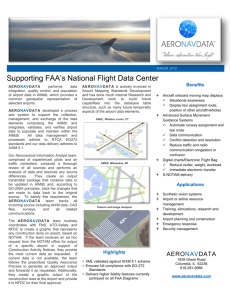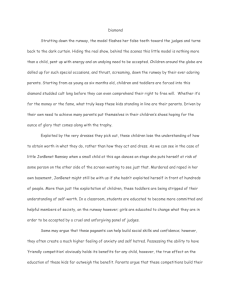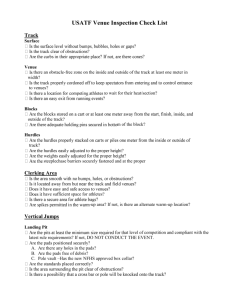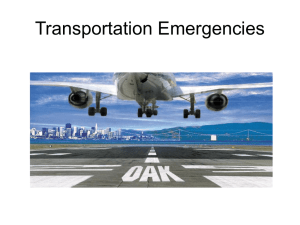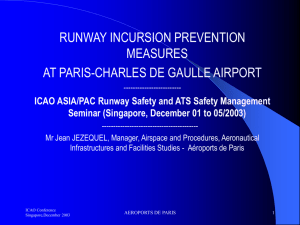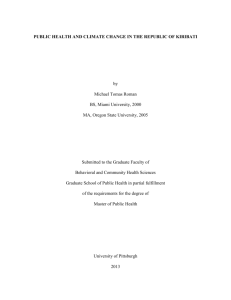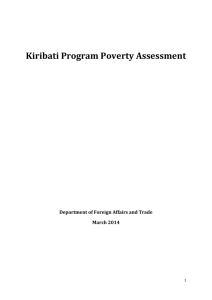PROJECT DESCRIPTION
advertisement
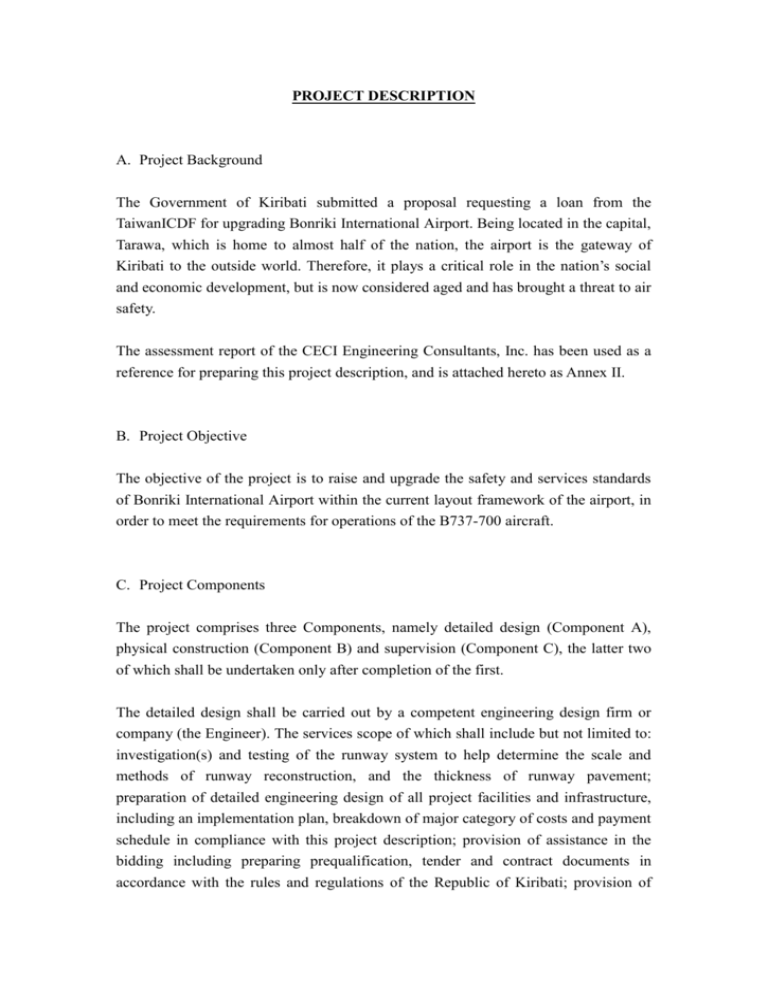
PROJECT DESCRIPTION A. Project Background The Government of Kiribati submitted a proposal requesting a loan from the TaiwanICDF for upgrading Bonriki International Airport. Being located in the capital, Tarawa, which is home to almost half of the nation, the airport is the gateway of Kiribati to the outside world. Therefore, it plays a critical role in the nation’s social and economic development, but is now considered aged and has brought a threat to air safety. The assessment report of the CECI Engineering Consultants, Inc. has been used as a reference for preparing this project description, and is attached hereto as Annex II. B. Project Objective The objective of the project is to raise and upgrade the safety and services standards of Bonriki International Airport within the current layout framework of the airport, in order to meet the requirements for operations of the B737-700 aircraft. C. Project Components The project comprises three Components, namely detailed design (Component A), physical construction (Component B) and supervision (Component C), the latter two of which shall be undertaken only after completion of the first. The detailed design shall be carried out by a competent engineering design firm or company (the Engineer). The services scope of which shall include but not limited to: investigation(s) and testing of the runway system to help determine the scale and methods of runway reconstruction, and the thickness of runway pavement; preparation of detailed engineering design of all project facilities and infrastructure, including an implementation plan, breakdown of major category of costs and payment schedule in compliance with this project description; provision of assistance in the bidding including preparing prequalification, tender and contract documents in accordance with the rules and regulations of the Republic of Kiribati; provision of assistance and consultation during the construction phase; amendment of the design upon the request of Republic of Kiribati; provision of assistance and consultation in the remedial works until the issuance of final acceptance of the construction by MCTTD etc. The physical construction shall be implemented in three sequential phases, which are described as follows: 1. Phase I construction Runway, apron, and taxiway system, and boundary fencing: The existing runway, apron, and taxiway are now presumed to be in a poor condition, as cracks are widely seen over the pavement surface, and a cave-in was found at the middle section of the runway, which might pose a huge risk to aviation safety. The project’s first priority is therefore to reconstruct and repave the runway, apron, and taxiway, based on the results of the aforementioned runway investigation(s) and testing, so that, to the extent that the Engineer in its professional judgment considers technically and financially feasible, the standards and recommendations published by the ICAO (International Civil Aviation Organization) or the FAA (US Federal Aviation Administration) for the B737-700 aircraft are met. However, due to space constraints of the airport site, no runway extension or widening works will be included in the project. Nevertheless, a foundation refilling and embankment construction work is required along the 27 end of the runway strip to fix the wave erosion problem and provide protection for the runway. Most of the boundary fencing has been removed by the local residents. To provide security for the airport, a new fence will be erected in this phase of construction. However, should the fence be built on the original site due to space limitation, according to the ICAO regulations, breakable materials shall be used. Even under this requirement, the fence shall be built in a way that is as least susceptible as possible, as assessed by the Engineer, to being removed or damaged by villagers. According to ICAO requirement, the walls of the fence facing the airport shall be painted with high-contrast, checker-pattern obstacle marks. In addition, circular service roads will also be constructed (for details see Section 3.5 of CECI’s report, and Point 3 of CECI’s supplementary report in Annex II). The Engineer may decide to repair the old jetty in the lagoon side nearby the airport, if it is considered an effective and economical means to transport construction materials or equipment to the construction site from Betio by sea, considering that land transport might cause damage to the roads. 2. Phase II construction Navigational aid facilities (NAVIDS): This phase of construction may only be commenced after progress of Phase I reaches at least eighty percent (80%) completion. This phase includes replacement and installation of runway and taxiway lights, a signal light, obstacle lighting and relating equipment or devices, to allow for operations under bad weather conditions or during nighttime. The backup generator has failed, and it will also be replaced in this project. 3. Phase III construction Terminal buildings, terminal area road and car parking: This phase of construction may only be commenced after progress of Phase II reaches at least eighty percent (80%) completion. The major task of this phase of works is to address the congestion problem in the terminal buildings. This will involve installation of new facilities such as baggage conveyers, interior renovation and layout rearrangement of the buildings, and terminal expansion work. The floor area to be created from the expansion depends on the scale of, and the budget used by its preceding phases of construction. The current plan is to construct a two-story building, joining the existing arrival and departure buildings on either side, generating some 670m2 of floor area. If there is a budget surplus from Phase I and II, the floor area could be further enlarged using such a surplus (for details see Section 3.3 of CECI’s report, and Point 5 of the supplementary report in Annex II). The surfaces of the road and car parking of the terminal area are either in a poor state of repair or not paved at all. A pavement upgrading or new pavement overlay will be done (see Section 3.3 of CECI’s report in Annex II). Overall, this phase of the project is intended to make the airport more pleasant and easily accessible for the passengers, visitors and staff. Component B shall commence only after the environmental license issued by Kiribati’s environmental assessment authorities is obtained. The Kiribati’s government is responsible for all relevant costs for obtaining the license. All phases of construction will be supervised by a competent firm or company (the Project Consultant), which will monitor and certify progress and quality of the works, take actions as necessary to ensure the quality is in accordance with the technical specifications and the Construction Contract, and issue certificates for payment. D. Financing Plan The TaiwanICDF will provide financing in the maximum aggregate principal amount in US Dollars not exceeding the equivalent of AUS$ 14,000,000 for the cost of project. All payments by the TaiwanICDF will be made in US dollars (and calculated based on the exchange rate furnished by the Borrower when requesting a Drawdown). The table below shows the preliminary financing plan for the project. Unit: ‘000 Australian Dollar Category TaiwanICDF loan Detailed design Kiribati’s Government counterpart funds Total Amount This component is fully funded by Kiribati’s Government Phase I construction 10,034 1,116 11,150 Phase II construction 1,068 121 1,189 Phase III construction 2,357 262 2,619 Supervision 541 61 602 14,000 1,560 15,560 Total The cost estimates for, and the allocations among, the three phases of construction may be modified or retuned (and the supervision may be altered accordingly) after conducting the runway investigations/ testing and then the detailed design. In any case, however, Kiribati’s government counterpart fund shall account for no less than 10% of each category’s cost, and the TaiwanICDF’s total financing for this project is capped at AUS$ 14,000,000.


